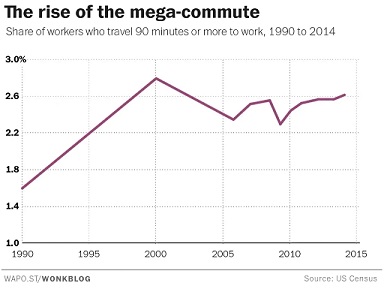Like many Americans, commuting to and form work is a big part of my life. In fact, for Heather and I, it took more than an entire year from moving to the suburbs to figure out our family’s commute to work and overall life logistics. I’ve loved solving puzzles since I was a kid, but this puzzle isn’t like any other I’ve attempted. It’s a beast and it tests every ounce of your patience, if not your sanity.
For example, depending on the day and what time our toddler needs to be dropped off and/or picked up form school, we juggle a myriad of different trains and train schedules, scale multiple highways with varying traffic patterns and navigate a group of parking garages that just take us to even more trains. Oh. And when winter rolls through, any “normal” day can quickly go from “I got this” to “I need alcohol and an IV drip”.
According to the U.S. Census Bureau and this Washington Post report, the average worker commutes 26 minutes to work. That’s a 20% increase since 1980. Increase!? Yes, increase with a plus. But what’s most interesting to me about this increase is that the number of mega-commuters (those commuting 90 minutes or more one-way) has gone up by 64% (from 1.6% during the 90’s to 2.62% in 2014). According to the data, there are more than 3.6 million Americans spending more than 3 hours each day traveling to and from their jobs. That’s just insane.
Now, to be fair, in tandem to this this increase in commute time is also an increase in the number of Americans working from home. According to the Census, the number of people working form home has almost doubled from 1980 to 2014. However, that doubling only brings us to a total of 4.4% of the overall workforce. Maybe it’s the Millennial in me, but I am a little shocked that working from home isn’t as popular as I thought it would be. Do companies not see how much untapped productivity they’re wasting?
And that’s just it. According to this report from EducatedDriver.org, most Americans will lose 408 days of their life commuting. As for me and Heather, the Regional Plan Association shows just how extra bonkers it is for those living around NYC. We’re not quite mega-commuters, but apparently we’d each be losing 561 days of our lives by commuting to work. For some, that’s startling enough to make significant changes to one’s work and life.
However, the WaPo article makes a good point in that not all people would allocate their recouped commuting time to something more productive. Of course, some folks are going to just binge watch more shows on Netflix, but that doesn’t also mean they won’t work a bit longer or harder at their jobs. It also doesn’t mean a side hustler won’t use the additional time grow their business and do away with their commute altogether. Honestly, it’s almost impossible for me to wrap my head around all the amazingly productive things that could be done with the 1.8 billion man-hours we lose to commuting each year.
However, it’s not just productivity that’s improved by recouping commuting time, but health as well. According to the article, “There’s a massive body of social science and public health research on the negative effects of commuting on personal and societal well-being. Longer commutes are linked with increased rates of obesity, high cholesterol, high blood pressure, back and neck pain, divorce, depression and death.” Personally, I didn’t need science to reveal these truths, but nevertheless, we’re literally killing ourselves going to work. So why do we do it?
Well, one reason, as this Pacific Standard article points out, is because another body of social science and economic research has shown that working face-to-face allows for complex tasks to be achieved more efficiently and effectively. Last year, I remember reading this The Atlantic article which did a great job reporting on this research in relation to IBM and their bombshell decision bring thousands of telecommuters back in house. Ironically, it was IBM who pioneered telecommuting in the late 70’s. Sure, not all jobs, especially complex ones, can or should be done remotely.
While I’ll buy that argument, I will also argue that the average commuting American isn’t working on complex, team-based projects. So what’s holding us back from a telecommuting renaissance? Well, I’ve always believed there are overarching generational mentalities at play. As MarketWatch highlights, Baby Boomers don’t adopt the same mindset about working from home as Gen X and Millennials do. On top of that most managers of Gen X and Millennials are Baby Boomers. Since they don’t appreciate telecommuting like younger generations do, they are less likely to offer it.
Moreover, it’s likely that Baby Boomers in managerial positions don’t relate to the logistical challenges facing their younger subordinates. After all, when many Boomers started their careers, social norms and family constructs were very different than they are today. For example, most households did not contain two college educated working spouses who have to work due to a number of challenging financial realities, from student loan debt to the high costs of housing and transportation. Today, however, this arrangement is far from atypical. If anything it’s commonplace and, more importantly, it makes thing a lot harder for a family of commuters.
We need to move quickly in a direction that has us look for greater flexibility in where and when we work. By offering even a day or two to work form home, we can start to unlock the 1.8 billion man-hours spent on commuting and apply them to other activities that either make us more productive, happier and healthier. We don’t need another study in the social sciences to know that these are all positives that beget more positives. Further, generational mindsets need altering. It’s every managers job, regardless if what generation they belong to or where their employee is working, to ensure that the job is getting done. Now you will have to excuse me, I have a train to catch.


